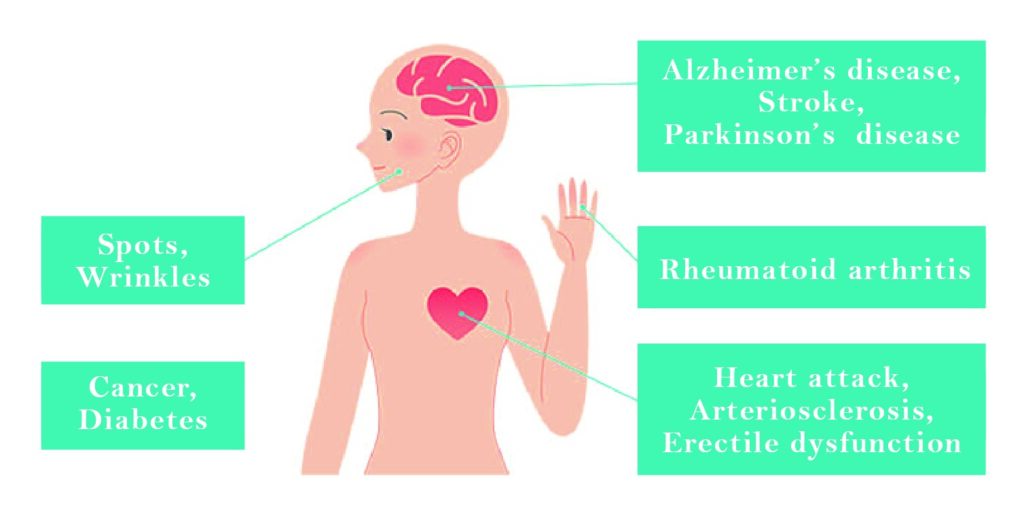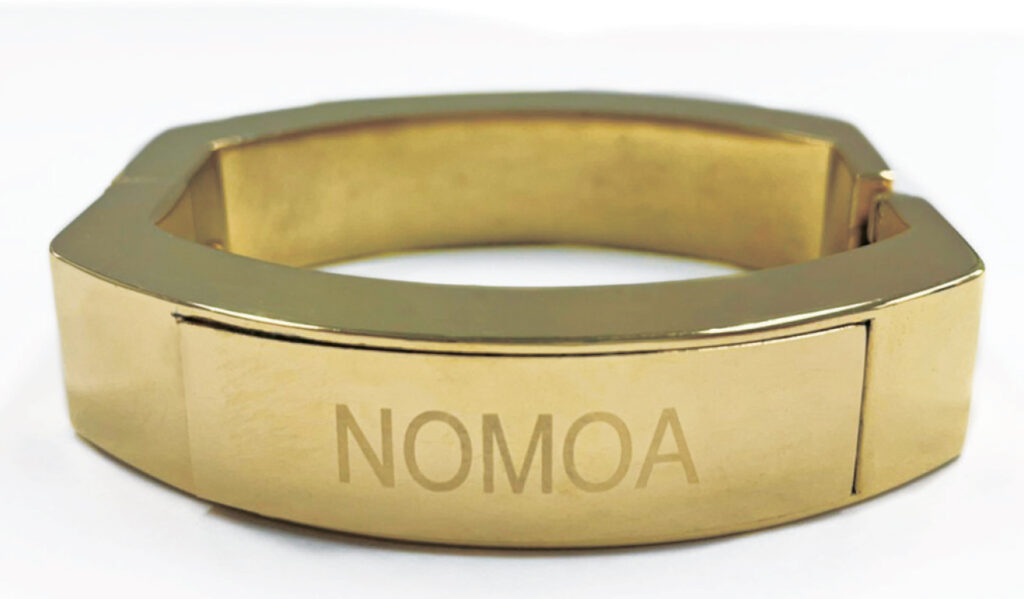Oxidative stress and reactive oxygen species
When we breathe, we take in oxygen into our bodies to produce energy to run our bodies. Part of the oxygen we take in is converted into a substance called reactive oxygen species. Many people have likely heard that an increase in reactive oxygen species is harmful to the body. Reactive oxygen species (ROS) have been attracting attention as a cause of many lifestyle-related diseases, from aging phenomena such as blotches and wrinkles on the skin to arteriosclerosis and cancer.

Reactive oxygen species (ROS) are oxygen species that have a very strong ability to oxidize other substances, but they do not only do bad things. They also play an important role in fighting off bacteria and viruses that invade the body. However, if the amount of reactive oxygen species increases too much, it can also attack normal cells and genes.
Reactive oxygen species and diseases
The main diseases in which reactive oxygen species are involved include arteriosclerosis, myocardial infarction, cerebral infarction, cancer, diabetes, and Alzheimer’s disease.

Reactive oxygen species are carried throughout the body by the blood. Therefore, they oxidize and destroy every organ in the body, causing diseases. It is said that as many as 90% of all diseases are triggered by reactive oxygen species. Cancer, heart disease, cerebral infarction, etc. have different parts affected, and at first glance it may seem that there is no connection between them, but they all have something in common: reactive oxygen species are deeply involved.
Of course, not everyone gets sick due to reactive oxygen species, but people with weak antioxidant capacity are more likely to get sick.
Reactive oxygen species and aging
There are so many theories about the causes of aging, but when we trace the root cause, we arrive at reactive oxygen species. The aging process occurs when the cells and tissues of the body, such as blood vessels, muscles, bones, and brain, are oxidized by reactive oxygen species and their functions deteriorate. The term “active” in reactive oxygen species means that they are easily reactive, and they immediately react with the lipids in the cells and change into a substance called lipid peroxide. This is the rust of the body. Lipid peroxides cause oxidative reactions at random, damaging cell membranes and leading to lifestyle-related diseases and aging.

In order to protect ourselves from the attacks of reactive oxygen species, our bodies are equipped with antioxidant power. However, it is said that the ability to scavenge reactive oxygen species peaks at the age of 20, after which it gradually declines, and by the time we reach our 40s, the negative effects of reactive oxygen species start to become noticeable. To compensate for the decline in antioxidant capacity, we need to make efforts not to increase the amount of active oxygen.
It is generally said that moderate exercise, taking in foods with high antioxidant power, eliminating lack of sleep and stress, and quitting smoking and excessive drinking are good ways to do this, but they need to be continued for one to two months for the effects to appear. In contrast, a revolutionary method has been discovered that reduces oxidative stress levels in the blood and does not lower the immune system by simply placing your fingers in the device for just 10 minutes.
NOMOA
– Inhibits the generation of reactive oxygen species in the blood without the use of drugs-

Reduces the level of reactive oxygen species in the blood
In 2010, at the World Congress of Clinical Pharmacology held in Copenhagen, Denmark, the world’s first study that succeeded in physically suppressing reactive oxygen species in the blood was presented.
In this study, blood samples were first taken from nine subjects, and the degree of oxidative stress (reactive oxygen species) in the blood (DROM) was measured, while at the same time BAP, which indicates immunity, was measured. After that, the index finger was inserted into the device for 10 minutes, and after the blood had circulated, the finger was removed, and the blood of all the subjects was taken again to measure the oxidative stress level and immunity. As a result, it was confirmed that the level of active oxygen decreased in all nine subjects. In all nine subjects, the level of reactive oxygen species (ROS) decreased, and immunity (BAP) did not decrease at all.
In other words, NOMOA reduced only the level of reactive oxygen species without lowering immunity.
Improvement of sleep disorders
We also prepared a NOMOA device that could hold the entire body of a mouse and tested the effects of sleep induction on the animal.
First, we put the mice in a cage and measured their behavior. Next, we prepared a NOMOA device that could hold the entire body of a mouse, and after letting it work for 10 minutes, we returned the mouse to its cage and measured its behavior again. We automatically measured this test for 23 hours for two mice each.
The average amount of behavior by sensor operating points per minute for mice that had not been exposed to NOMOA was 52.7 points, whereas the amount of behavior for mice that had been exposed to NOMOA was 48.7 points per minute on average, a 7.6% decrease. This demonstrated that the duration of behavioral cessation was prolonged in mice treated with NOMOA.
It can be said that NOMOA induced drowsiness in the mice, as there are references that suppressing the oxidative stress level (amount of reactive oxygen species) in the blood induces sleep.
It has been proven that NOMOA suppresses reactive oxygen species (ROS) in the blood and prevents diseases such as diabetes, arteriosclerosis, hypertension, and myocardial infarction caused by ROS, as well as eliminating sleep disorders caused by oxidative stress.
Improvement of high blood pressure
In 2018, the world’s first research presentation on physically lowering blood pressure without using drugs was made at the the International Society of Clinical Pharmacology, held in Kyoto, Japan. The ankle-worn version of the NOMOA was used at that time.
In the study, 19 subjects wore the control, the magnet, and the NOMOA in that order for 24 hours, and then wore a blood pressure monitor on their bodies that could measure blood pressure continuously for 24 hours.
When the subjects wore the control, their blood pressure did not change, and when they wore the magnet device, their blood pressure increased, but when they wore the NOMOA, their blood pressure decreased by an average of about 5 mmHg.
From these research results, it was proven that the use of NOMOA can reduce blood pressure and suppress active oxygen, which causes diseases such as diabetes, hypertension, and thrombosis, as well as aging.